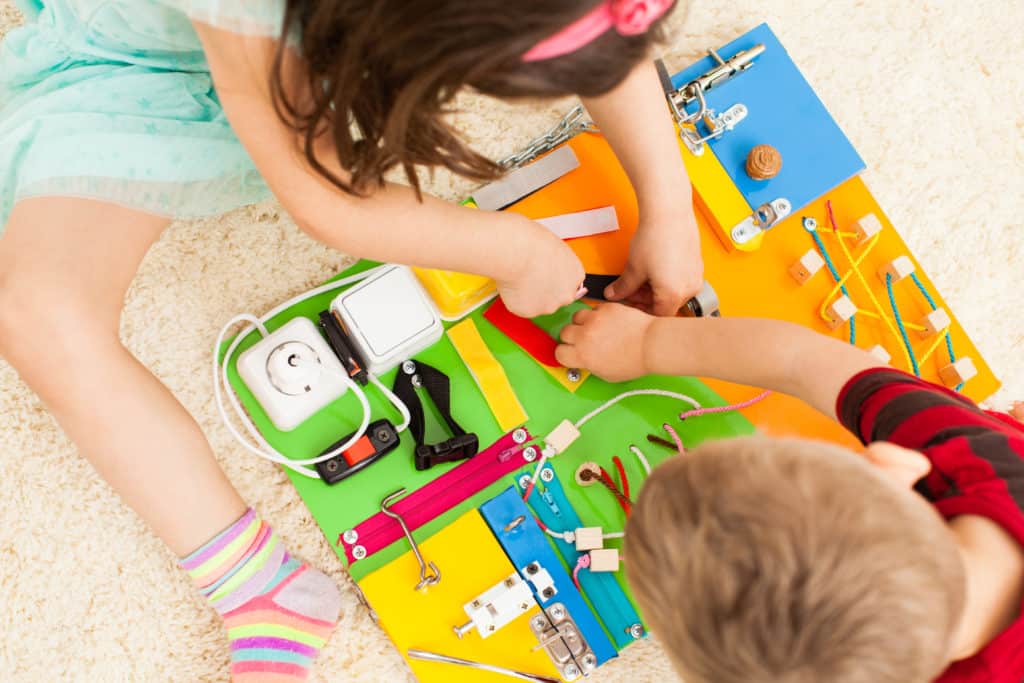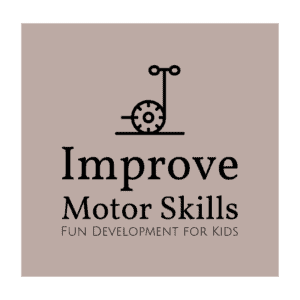Making or buying a busy board for the littlest ones to improve their various skills is an increasing trend. But before you get one for your kid, you should know their benefits and also their possible downsides. So what are they exactly?
Busy boards are sensory toys, usually made from various every-day items, that improve the child’s fine motor skills, problem-solving skills, and much more. Quite often, busy boards are taken up as DIY projects, as they are relatively easy and cheap to build.

To get a better overview of what they really are and how they will benefit your child, read on.
What are Busy Boards?
As mentioned before, busy boards are relatively simple toys to make yourself. They can be assembled in countless ways – it’s commonly a combination of various materials (wood, metal, cloth, even plastic), various components (hooks, zippers, bells, etc), put together in various colors and designs.
The base of a busy board is usually a piece of plywood and the components come in different materials to provide varied sensory feedback when touching them.
The list of possible components for a busy board can go on for pages but here are some of the more common ones that you might want to consider for yours:
- Zipper
- Hooks
- Latch
- Small windows or hatch
- Two strings that can be tied together
- Two gears that turn each other
- Bike bell
- Switch and a lamp
- A rollable wheel
- A velcro strip
- A clock with movable hands
- A bolt and a nut
- A padlock with keys on a chain
- A plastic pipe and a bin below to roll small balls through
- A fidget spinner
- …
Quite often, this is all that a busy board is – a blank plywood sheet with some components screwed to it. But if you want a more aesthetically pleasing busy board or are looking for some specific themes on your busy board, search Pinterest for “busy board” and you’ll get hundreds of cool ideas for your DIY project.
What are Busy Board Benefits for Infants and Toddlers?
Busy boards are complex toys that have multiple benefits for kids:
- Improving fine motor skills
- Improving problem-solving skills
- Helping to understand cause/effect relationship
- Teaching real-life skills
- Giving sensory feedback
Read on to learn more about each of them.
Improving Fine Motor Skills
Busy boards are usually designed to cover a wide range of activities, from rolling wheels and ringing bells to opening zippers and hooks. Each of these activities requires different finger movement patterns and repeatedly practicing them will get your kid on the next level with those fine motor skills.
Improving Problem-Solving Skills
When you introduce a busy board to your child, try to find or make one where most of the activities are new to the child. This will give them a chance to tackle their problem-solving skills when trying to figure out how each of the ‘puzzles’ are solved.
Try not to interrupt too early if the child is struggling with some of the activities, they will probably get the hang of it at some point. With our daughter, we’ve found that the SHOW method promoted in Montessori education works really well when introducing this type of toys and activities. SHOW stands for Slow Hands Omit Words, meaning we show her a couple of times really slowly how something works without saying anything, and then we leave her to try it out for herself.
Helping to Understand Cause/Effect Relationship
Playing with a busy board helps the kids understand that their actions have effects. They push a button and a light goes off. They push it again, and it comes back on. This is a critical step in their development that allows them to understand and adapt to the world around them.
Teaching Real-Life Skills
Busy boards are usually built with items that people come in touch with on a daily basis: zippers, hooks, buttons, etc. So having such a board for your toddler provides them with methods to practice the skills they will need in life in a fun way.
Giving Sensory Feedback
There are multiple levels of feedback kids will get from a busy board: visual, tactile, and auditory.
Visual feedback – kids will do an action and see the result. Like switching a light on and off, or opening and closing a hatch. This will trigger them to repeat their actions.
Tactile feedback – kids will touch various materials (wood, metal, cloth, etc) and learn how they feel and react between their fingers – a metal hook is cold and hard to touch, while a piece of cloth is soft.
Auditory feedback – some of the items can also send auditory feedback which is needed to understand the world better – the sound a zipper makes when pulled, the ring of bicycle bell, turning gears etc.
What are Busy Board Benefits for Parents?
Busy boards are great toys for infants and toddlers, but they also have benefits for parents:
- Easy DIY project
- Affordable
- Allow expressing parents’ imagination
- Provide a minute of free time
Easy DIY Project
Busy boards are relatively easy and cheap to build yourself. It just takes a piece of plywood, some general tools, screws (or bolts and nuts) and some movable items to attach to the base. Check the list of possible ideas from the first paragraphs of this article.
Affordable
If you decide that making one is not your cup of tea, just buy it – they won’t cost much. The price does vary quite a bit depending on the size of the board, materials used and number of activities but simpler ones are around $20 and you can get a very nice one for around 40 bucks.
Allow Expressing Parents’ Imagination
If you decide to build a busy board yourself, it’s a great opportunity to express yourself and create something from your heart. There are so many options to vary the way your busy board will look and act like, so just be open-minded and create something awesome for your kid. Consider different colors, themes, positioning similar elements into groups, etc.
Provide a Minute of Free Time
Playing with a busy board can be a time to be with your kid but it can also be the time to relax. Busy board is a great independent activity for your kid and, as the name suggests, keeps the kid busy for quite some time, especially when learning new skills. This gives you the possibility to enjoy that much-needed cup of coffee or just lay on the couch.
What are the Downsides of Busy Boards?
I can’t think of any universally negative aspects but there are some approaches to teaching kids that don’t necessarily align with the busy boards. One of them is the Montessori method of education.
According to the Montessori method, materials (‘material’ = tool, toy, etc) given to the child should (1) have a very specific goal, and (2) be isolated from other distractive materials. In terms of busy boards, there are multiple goals with the same toy, so a child might not fully focus on the details of the game but just keep bouncing from element to element.
One way to make busy boards a bit more Montessori aligned would be to make or buy several smaller ones with specific types of tasks. For example, one with hooks, latches, and locks for opening and closing skill practice, another with zippers, velcro, and buttons for self-dressing skills, etc.
Now, the decision is yours – do you see this focus issue as something negative, or is this not a problem with your approach. While we support many ideas from the Montessori method, we haven’t found this an issue for us and have built a ‘self-dressing’ busy board for our 16 months old daughter.
Another thing to perhaps keep in mind when making or choosing a busy board is whether you want it to include any electrical cords or power outlets. Most toddlers seem to be drawn to power outlets and cords at one point or another and it can be quite a struggle to get your kid away from them. Some parents find that including this type of activity on a busy board is a safe way to let their kid explore these items while others argue that it gives kids a false sense of security and urges them to play with real cords and outlets off the busy board as well. Again, it’s completely up to you whether you want them on your busy board.
Conclusion
While there might be a few minor downsides to the busy boards, they definitely have more pros for your little one. So roll up your sleeves and take this up as your next DIY project.

One thought on “What are Busy Boards and What are their Benefits?”